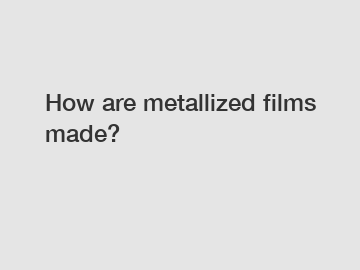Feb. 12, 2024
Packaging & Printing
You will get efficient and thoughtful service from Firsta.
How are Metallized Films Made?
Metallized films, also known as metallized plastic films, are widely used in various industries for packaging, labeling, and decorative purposes. They offer several advantages over traditional materials, including improved barrier properties, enhanced aesthetics, and increased shelf life for products. But have you ever wondered how these metallized films are made? In this article, we will explore the manufacturing process of metallized films, from the selection of base films to the application of metal coatings.

Selection of Base Films.
The first step in the production of metallized films is the selection of suitable base films. These films can be made from various polymers such as polyethylene terephthalate (PET), polypropylene (PP), polyethylene (PE), or polystyrene (PS). The choice of base film depends on the specific requirements of the application, such as the desired barrier properties, flexibility, and heat resistance.
Coating Preparation.
Once the base film is selected, it goes through a coating preparation stage. In this stage, the base film is treated to ensure proper adhesion of the metal coating. The surface of the film is cleaned and treated with a corona discharge or flame treatment to create microscopically roughened surfaces. This process improves wettability and enhances the bonding between the base film and the metal coating.
Metallization.
After the coating preparation, the metallization process begins. The base film is loaded onto a specially designed machine, where it is introduced into a vacuum chamber. Inside the chamber, metal wire or foil is vaporized using either resistance heating or electron beam evaporation. The metal vapor condenses onto the prepared surface of the base film, forming a thin metallic layer.
The thickness of the metal coating can be controlled by adjusting the processing parameters, such as the temperature, pressure, and deposition time. Typically, the metal coatings used in metallized films include aluminum, zinc, gold, or silver, depending on the desired appearance and functionality.
Coating Lamination.
Once the metallization process is complete, the metallized film may undergo a lamination process. This involves bonding the metal-coated film with other films or substrates to create a composite structure. Lamination can enhance the overall strength, durability, and functionality of the metallized film, making it suitable for specific applications such as food packaging or industrial labeling.
Finishing and Quality Control.
After lamination, the metallized films go through various finishing processes. These may include slitting, cutting, or printing, depending on the specific requirements of the customer. The finished metallized films are then subjected to rigorous quality control measures to ensure they meet the desired specifications in terms of thickness, adhesion, uniformity, and appearance.
Conclusion.
In summary, metallized films are produced through a carefully controlled manufacturing process. From the selection of base films to the metallization and finishing stages, every step is crucial in achieving the desired properties and functionality of the final product. Metallized films continue to be in high demand due to their ability to combine the advantages of both plastic and metal materials. Whether you are looking to enhance the visual appeal of your product's packaging or improve its barrier properties, metallized films offer a versatile solution.
If you are interested in utilizing metallized films for your packaging, labeling, or decorative needs, contact us today for more information on our range of metallized film products.
Contact us.
If you want to learn more, please visit our website.
If you want to learn more, please visit our website aluminized pet film.
Previous: How to Maximize Efficiency with Multiwell Plates?
Next: Are Disposable Microwave Popcorn Bags Harming the Environment?
If you are interested in sending in a Guest Blogger Submission,welcome to write for us!
All Comments ( 0 )